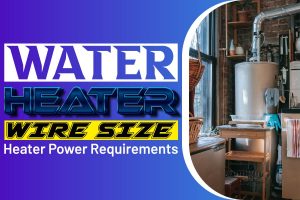You know how you like using hot water on your sink and shower when it’s cold? That relaxing feeling you get when hot water pours down your back is like no other, and it is all thanks to a water heater installed in your basement.
The heater will work, and you will enjoy the hot water as long as it gets enough power to heat the water.
Since they are connected to the mains using cables, you need to pick the right cable for your heater to work well. Let us get into this topic and see exactly what your heater needs for it to work perfectly.
Water Heater Wire Size
The exact wire you use will depend on the size of your water heater. If your heater is a 20 amp, you will need a 12-gauge wire to supply enough power. A 25 amp heater will use a 190-gauge wire, and you can use an 8-gauge or 6-gauge wire for a 30 to 40 amp water heater.
You can use a low gauge wire to be safe since it can work well whether your heater is lightweight or heavyweight. Using a wire that is too small will deny your heater the power it needs to function optimally.
How Does An Electric Water Heater Work?
Almost every American home has a water heater, they differ in size and design, but they are present.
We all enjoy using hot water, but there is a satisfaction with knowing how the water became that hot. Let us look inside the water heater and understand how it works;
Most electric heaters use two heating elements to heat the water in the tanks. Once the set temperature is attained, the elements will get turned off, and they will come back on if the temperature drops.
Turning on and off is an addition to reducing the electrical energy used up by the heater. A lower temperature setting will rarely turn on the heating element. Thus it will save you a lot of power.
Most manufacturers recommend a temperature setting of 1200F or lower. The heating elements and the tank are both vital in the operation of a heating tank. The pipes connecting to the heater join into galvanized steel pipes on the heater.
Most houses have copper piping; thus, they need a dielectric union in connection with a heater. If the union is not used, the pipes will deteriorate and break because of electrolytic corrosion.
The cold water pipe coming into the heater is connected to the heater’s dip tube, which distributes the cold water to the bottom of the tank.
This makes sure the water is properly heated before it comes back to the top of the tank to be pumped into your house.
Without the dip tube, the water will stay at the top of the tank, and it won’t get heated. The inside of the heating tank is metal, but it is coated to protect it from the water or any minerals that could corrode it.
In addition to the coating, there is an anode rod in the heater to attract corrosive minerals so they don’t attack the tank’s walls.
Some minerals might attack the anode and cause a Sulfur smell, don’t remove the anode since the minerals will now attack the walls.
These minerals will eventually build up at the bottom of the tank. There is a drain valve at the bottom of the heater; you can use this valve to get rid of the minerals once every few years to keep your heater in optimal performance.
The tanks come with automated water and pressure relief valves. This is an emergency feature to prevent your tank from exploding if the temperature or pressure goes higher than the tank can safely handle.
You need to install a discharge valve on the valve to pump the water away and keep the basement dry.
Water Heater Checkup And Repair Guide
Just like you go to the doctor regularly for checkups even if you are not sick, a water heater needs to be assessed even if it is working correctly. This is a big part of ensuring that the heater keeps performing even after it gets old.
- Turn off the water supply pipe, then carefully look at all the heater’s parts for leaks. Any leaks, as insignificant as they may be, could lead to bigger problems in the future. The valves and inlets are the most important parts, and they shouldn’t leak.
- If you have a gas heater, you need to ensure the airflow is perfect. The air intake pipes could get blocked, and it could cause back drafting, which might blow out the pallets. Clean underneath the heater to prevent these issues from coming up.
- The temperature and pressure relief valve is the most important safety feature on a heater. You need to inspect and test your relief valve to make sure it can work when needed. If there is a leak in your valve or it doesn’t work in any way, replace it before you use the heater again.
- Check the anodes in your heater to see if they are corroded. It would be best if you reduced the pressure in the tank before taking the anode out, lest the water will spew out and scald you.
If the rod is corroded, you should replace it to protect the wall of your heater from minerals in the water.
Please take note of your anode’s corrosion rate since it varies depending on the local water Ph. Levels.
Water Heater Power Requirements And Use
With the powerful cables you connect to your heater, you must be curious about what exactly the heater does with the power.
Connecting a power cable that cannot provide enough power will cause the heater to work incorrectly or not at all. Here are the details on what the heater does so you understand why it needs a lot of power;
Standard electric water heater needs 240 volts of alternating current to make their heating elements work. These two elements are placed at the middle of the tank and the bottom, respectively.
Each heating element is linked to an independent thermostat. These thermostats maintain the water temperature inside the tank by turning the elements on and off.
This happens by their opening and closing contacts that allow voltage to get to the heating elements.
The elements come on one at a time, and their frequency of operation depends on the user’s temperature settings.
There are fuses and circuit breakers included in the circuitry of a heater to keep the current in check and the heater safe.
If your heater is not working, one of the fuses could have brown, or a circuit breaker could have been tripped.
Check the reset button to see if it has been tripped, and look at the components to see if they are working correctly before turning the power back on.
Water Heater Safety Tips
A water heater uses a lot of electricity, adding this to the fact that it deals with hot water under a lot of pressure, it becomes a potential bomb.
If you don’t maintain it correctly, a water heater could burn you or blow up and destroy your home.
The correct use and proper maintenance will ensure you don’t have any issues while using a heating tank, even for a long time. Here are some tips you can use to keep everyone safe, even when using a heater.
- If you notice any pressure or release valve leaks, turn off the heater and change the faulty valve. Without the pressure release valve, your heater might be at risk of exploding since it won’t be able to reduce its pressure levels.
- Install a discharge tube on your pressure release valve and have it go 6 inches above the floor. This is important since the water coming out of the valve is always scalding hot, and it could splash out at great pressure and burn you.
- If there is a leak anywhere in the tank, the incoming water pipe should be shut off immediately. This is because a small drip can escalate, especially with the tank’s pressure levels.
- Insulate both the incoming and outgoing pipes to prevent the heater from losing heat. This will save your electricity, and it could also prevent burns from touching the hot water pipe.
- Use flexible water supply pipes if your area is prone to earthquakes. This will prevent the pipes on your heater from breaking, and they will save you from incurring even more damages.
Conclusion
The size of wire you use on your water heater depends on your heater’s size and power requirements.
The best thing to do is check your heater’s specification and provide it with a wire that can give it the power it needs.
You need to regularly inspect your heater to make sure all its components work correctly. This will save you the stress of buying a new heater or repairing damages caused by one that exploded.





















